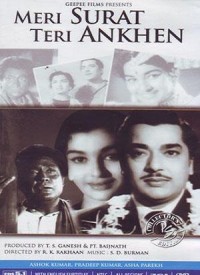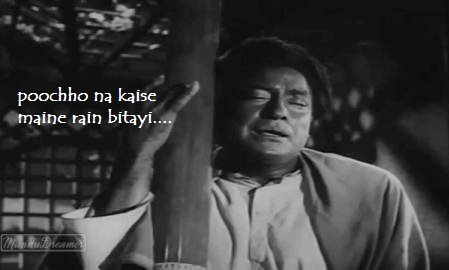Raaga Based Song of the Day: Poochho na kaise main rain bitayi…
Raag Ahir Bhairav, Tal Kaherava
I am sorry I was away for a trip to Kinnaur and Kaza and I had to suspend Raaga Based Song of the Day from 19th to yesterday, 28th June 17. For a few days, I was out of all networks let alone Internet.
We have completed twenty-one days of Raaga Based Songs of the Day. Our first post in the series was titled ‘Raaga Based Song Of The Day #1’ and the song was a Mohammad Rafi and Lata Mangeshkar song from the 1970 Shakti Samanta movie Pagla Kahin Ka: Tum mujhe youn bhula na paoge. It is in Raag Jhinjhoti, Tal Kaherava.
Our twenty-first post or the last post on 18th June was titled ‘Raaga Based Song Of The Day #21’ and the song was a Lata Mangeshkar song from the 1961 Sadashiv J Row Kavi movie Bhabhi Ki Chudiyan: Jyoti kalash chhalke. It is in Raag Bhupali, Tal Kaherava.
This blog has a number of posts on Raaga based songs in Hindi movies titled similarly; for example: ‘The Best Raaga Based Songs in Hindi Movies – Raaga Darbari Kanada – Part III’.
First, for the value added learning of today, lets find out the essential difference between Thaat and Raag Bhairavi and Thaat and Raag Bhairav:
Bhairavi has all the komal (soft) swars: Rishabh, Gandhar, Dhaivat, and Nishad. When rendering compositions in Bhairavi raag, the singers however use all the 12 swars. Bhairavi raag is named after the shakti or feminine aspect of the cosmic life force, which is personified as a consort to Lord Shiva. I have already given you the finest composition in Raag Bhairavi in Hindi films: Babul mora naihar chhooto hi jaaye, originally created and composed as a thumri by Nawab Wajid Ali Khan when the British exiled him from his favourite city Lucknow but sung by KL Saigal later. Because of that post: ‘Raaga Based Song Of The Day #11’, you already know that Bhairavi is a powerful raag filled with devotion and compassion. I also told you that Bhairavi is normally performed as the concluding piece in a full night of raaga based recitals since it is supposed to ‘cure’ the errors of earlier performances or renditions. It is also an early morning raaga since the concluding piece of such overnight performances is early in the morning. It is easy to guess that Bhairavi is the female form of Bhairav, ie, Lord Shiva.
Some of the raags in Bhairavi Thaat are: Malkauns, Bilaskhani Todi, Bhupali Todi, and Kaunsi Kanada.
Bhairav thaat raags make use of Komal Rishabh and Komal Dhaivat. Bhairav is one of the names of Lord Shiva especially in his powerful form as a naked ascetic with matted hair and ashes smeared body. The raaga too has some of these masculine and ascetic attributes in its form and compositions. The raaga itself is extremely vast and allows a huge number of note combinations and a great range of emotional qualities from valour to peace. There are many variations on raag Bhairav including (but not restricted to) Ahir Bhairav (though not menmtioned in Bhatkhande’s system), Alam Bhairav, Anand Bhairav, Bairagi Bhairav, Beehad Bhairav, Bhavmat Bhairav, Devata Bhairav, Gauri Bhairav, Nat Bhairav, and Shivmat Bhairav. This raag is usually performed in a devotional mood in the early morning hours. The vibrations of the notes in Bhairav are said to clear one’s whole mind. The pictorial depictions of raag Bhairav in the ancient texts are austere as well as awe-inspiring.
Some of the Raagas in Bhairav Thaat: Ramkali, Gunkari, Meghranjani, Jogiya, and Bhairav.
 Today, I shall be giving you a song composed in Raag Ahir Bhairav. I have thought of this raaga as the most appropriate raaga to give you today as only day before yesterday, my wife and I visited the famous temple of goddess Bhimakali at Sarahan, about 210 kms from my home-place Kandaghat, during our trip to Kaza and back. This temple is one of the 51 Shakti Peethas in India. Since I have already given you a song in Bahiravi, it is only appropriate that I give you one in Bhairav now.
Today, I shall be giving you a song composed in Raag Ahir Bhairav. I have thought of this raaga as the most appropriate raaga to give you today as only day before yesterday, my wife and I visited the famous temple of goddess Bhimakali at Sarahan, about 210 kms from my home-place Kandaghat, during our trip to Kaza and back. This temple is one of the 51 Shakti Peethas in India. Since I have already given you a song in Bahiravi, it is only appropriate that I give you one in Bhairav now.
Ahir Bhairav, as the name suggests, is a raaga of the Bhairav Thaat, one of the ten thaats that Vishnu Narayan Bhatkhande researched and found almost all raagas are based on. It is a mixture of Bhairav and the ancient but now rare raga Ahiri or perhaps a mixture of Bhairav and Kafi. Ladies and gentlemen, now that I have given you the essential differences between Bhairavi (consort of Lord Shiva) and Bhairav (Lord Shiva Himself), I hope you will never confuse Thaat and Raag Bhairavi with Bhairav.
Some of the songs composed in Ahir Bhairav are: Apne jeevan ki uljhan ko, Mai ri main kaase kahun, Main to kabase teri sharan main hoon, Man anand anand chhayo, Meri veena tum bin roye, Ram teri Ganga maili ho gayi, Solah baras ki baali umr ko salaam, and Waqt karta jo wafa aap hamare hote.
 The song that I have selected for you is from the 1963 RK Rakhaan movie Meri Surat Teri Aankhen starring Ashok Kumar as Pyare, an ugly son born to Ishwarlal as Raj Kumar and Achla Sachdev as his wife Kamla Kumar. Because he was dark and ugly at birth, Ishwarlal decided to get rid of him to Kanhaiyalal Chaturvedi as Rahmat and Paro as his wife. He grows up in seclusion and Rahmat teaches him classical based singing. His voice is as beautiful as physically he is not. In later life he comes in touch with his parents, his brother Pradeep Kumar as Sudhir who is betrothed to Asha Parekh as Kavita, the woman that Pyare feels is in love with him despite his ugliness.
The song that I have selected for you is from the 1963 RK Rakhaan movie Meri Surat Teri Aankhen starring Ashok Kumar as Pyare, an ugly son born to Ishwarlal as Raj Kumar and Achla Sachdev as his wife Kamla Kumar. Because he was dark and ugly at birth, Ishwarlal decided to get rid of him to Kanhaiyalal Chaturvedi as Rahmat and Paro as his wife. He grows up in seclusion and Rahmat teaches him classical based singing. His voice is as beautiful as physically he is not. In later life he comes in touch with his parents, his brother Pradeep Kumar as Sudhir who is betrothed to Asha Parekh as Kavita, the woman that Pyare feels is in love with him despite his ugliness.
The film had some of the best raaga based songs ever heard in Hindi movies. The lyricist of these songs was Shailendra, composer was Sachin Dev Burman with the following singers. Have a look at the list:
- Poochho Na Kaise Maine Rain Bitaayi – Manna Dey
- Ye Kisne Geet Chheda – Mukesh, Suman Kalyanpur
- Puchho Na Kaise Maine Rain Bitayi (Sad) – S.D. Batish, Manna Dey
- Naache Man Moraa Magan Dhigadhaa Dhigi Dhigi – Mohammed Rafi
- Tere Khayalo Me Tere Hi Khawabo Me – Lata Mangeshkar
- Tere Bin Soone Nain Hamare (Sad) – Mohammed Rafi
- Tere Bin Sune Nain Humare – Lata Mangeshkar, Mohammed Rafi
- Tujhse Nazar Milane Me – Asha Bhosle
Please enjoy one of the best from the movie in Raag Ahir Bhairav, Tal Kaherava with the singer Manna Dey singing a composition of SD Burman on the lyrics of Shailendra: Poochho na kaise maine rain bitayi….
The song is sung when Pyare’s foster father Rahmat is dying.
Poochho naa kaise maine rain bitaaI
ik pal jaise, ik yug biitA – 2
yug biite mohe nii.nd naa aayii
poochho naa kaise …
(Naa kahii.n cha.Ndaa, naa kahii.n taare
jyot ke pyaase mere, nain bichaare ) – 2
bhor bhii aas kii kiran naa laayI
poochho naa kaise …
Ik jale diipak ik man meraa, merA, man, merA, merA …
ik jale diipak ik man meraa
phir bhI naa jaaye mere ghar kaa a.ndheraa
ta.Dapat tarasat umar ga.nvaayii
poochho naa kaise …
We have intended to learn about Raaga based music whilst we entertain ourselves with Raaga based songs. So, lets, once again, take stock of our collective learning so far:
- On the first day we learnt about the Raaga system devised by Pandit Vishnu Narayan Bhatkhande, which is the prevalent system in Hindustani Classical Music and based on ten Thaats.
- On the second day we learnt about Tal or Taal.
- On the third day we learnt about characteristics of Raagas that included Swar, Jati, Thaat, Arohana and Avarohana, Vadi, Samvadi and Pakad.
- On the fourth day, we learnt about Sargam.
- On the fifth day, we learnt about notations used in Indian classical music or simply Swar Lipi.
- On the sixth day, we learnt about the Ras (sentiments) that Raagas evoke.
- On the seventh day, we learnt about various types of Swar: Shuddha, Achal, Vikrut, Komal and Teevra.
- On the eighth day, we learnt the parts of a composition in Indian Classical Music.
- On the ninth day, we learnt the names of some of the popular instruments used in Indian Classical Music.
- On the tenth day, we learnt about the sources of names of Raagas.
- On the eleventh day, we learnt about why Bhairavi is the first raag to be taught to beginners and also why it is the last in a performance.
- On the twelfth day, we learnt about Khammaj Thaat.
- On the thirteenth day, we learnt about Tal Punjabi Theka or Sitarkhani.
- On the fourteenth day, we learnt about Alap.
- On the fifteenth day, we learnt about List of Raagas (Raagmala) in my favourite book: Sri Guru Granth Sahib.
- On the sixteenth day, we learnt about tips for raaga identification.
- On the seventeenth day, we learnt the basics of Gharana system.
- On the eighteenth day, we learnt about Filmi Sangeet.
- On the nineteenth day, we learnt about the commonest Tal in Raagas: Tintal.
- On the twentieth day, we learnt about the Kafi Thaat.
- On the twenty-first day, we learnt a little more in detail about the classification of Raagas.
- And today, on the twenty-second day, we learnt the essential differences between Bhairavi and Bhairav.
There is much more still to be learnt and enjoyed.
Please stay tuned!
